Smart Small Kitchen Design for 10x10 Spaces
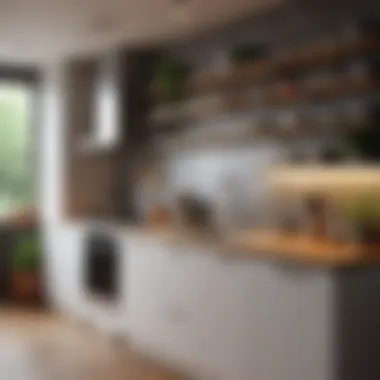
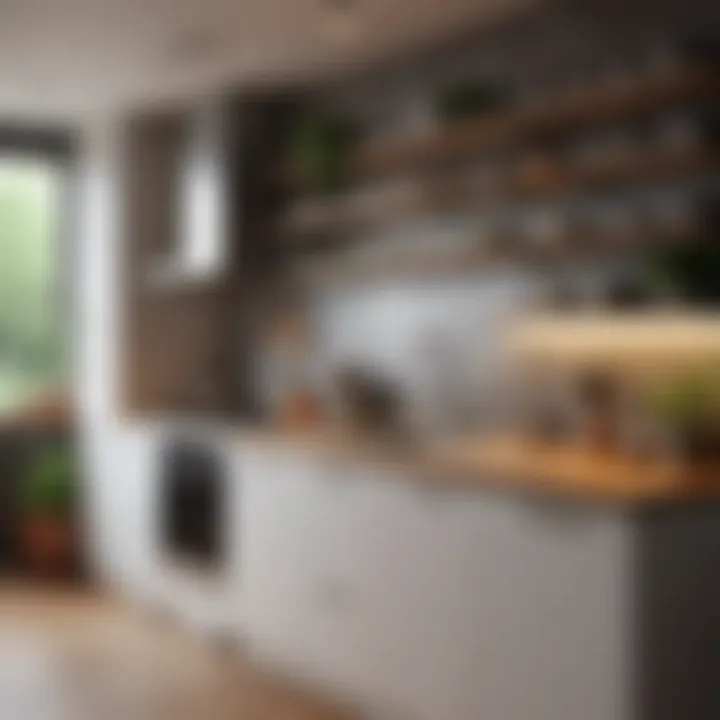
Intro
Designing a kitchen, especially a small one measuring 10x10 feet, can seem daunting. However, with the right insights and practical strategies, homeowners can transform this modest space into a functional and stylish area. This article reveals the essential elements that contribute to effective small kitchen design. From understanding current trends to practical tips on materials and layout, this guide offers valuable information for homeowners and design enthusiasts.
Key Insights and Trends
Current Trends in Interior Design
In recent years, the focus in kitchen design has shifted towards maximizing efficiency while maintaining aesthetics. Some notable trends include:
- Minimalism: Less clutter and sleek surfaces dominate the design landscape. A minimalist kitchen can make the space feel larger and more organized.
- Multi-functional Furniture: Items like kitchen islands that can serve as dining areas or extra storage spaces are gaining popularity.
- Natural Materials: Wood and stone are favored for their durability and natural beauty.
Understanding these trends can help homeowners select elements that not only look good but also work well in smaller spaces.
Popular Design Layouts
When it comes to kitchen layouts, there are several options to consider for a 10x10 space:
- L-Shaped Layout: Efficient and space-saving, this design utilizes two adjacent walls, leaving the center open for movement.
- Galley Layout: Recognized for its narrow passage, the galley layout maximizes storage and workspace, making it ideal for small kitchens.
- U-Shaped Layout: This design offers ample counter space but can feel cramped if not designed carefully. It's best for those who prioritize cooking space over dining.
Practical Tips and How-To Guides
Step-by-Step Guide to Choosing a Layout
- Assess Your Needs: Consider how you use your kitchen. Do you cook often? Do you entertain guests?
- Measure Your Space: Accurate measurements allow for better planning. Determine where appliances and fixtures will go.
- Choose the Right Layout: Based on your needs and space, select a layout that suits you best.
- Plan for Storage: Install cabinets that reach the ceiling to maximize storage and minimize clutter.
- Consider Traffic Flow: Ensure there is enough space for movement between the refrigerator, sink, and stove.
Material Selection for Small Kitchens
The right materials can enhance both functionality and aesthetics. Some recommendations include:
- Quartz Countertops: Durable and stylish, they are low-maintenance options that resist stains.
- Open Shelving: Creates an airy feel and provides easy access to kitchen essentials.
- Light Colors: Lighter shades can make a compact kitchen appear larger and more inviting.
"Designing a small kitchen requires a balance of aesthetics and functionality; each element must serve a purpose."
Final Thoughts
Transforming a 10x10 kitchen involves thoughtful planning and execution. By staying informed on trends and practical design solutions, homeowners can create spaces that are not only functional but also visually appealing. Continually evaluating layout options, materials, and storage solutions will ensure an efficient kitchen that enhances everyday living.
Understanding the 10x10 Kitchen Dimension
A 10x10 kitchen space presents unique opportunities and challenges in design. Understanding this dimension is crucial for effective planning, as it determines how to optimize layout and functionality. This type of kitchen often serves as both a cooking area and a social hub, making the design choices you make particularly significant.
Significance of Kitchen Size
The size of a kitchen influences its usability and aesthetics. In a 10x10 kitchen, every inch matters. Homeowners must consider how to maximize functionality while maintaining a comfortable flow. A kitchen of this size can easily become cramped if not designed properly. Therefore, optimizing the layout to include adequate storage, appliances, and workspace is essential.
Additionally, it is vital to think about how the kitchen fits into the overall home layout. An understanding of the kitchen's size helps in creating seamless transitions to adjacent living spaces. People often socialize in the kitchen during gatherings, emphasizing the importance of an inviting yet functional design. This is where a well-thought-out kitchen becomes more than just a cooking area; it serves as a gathering point for family and friends.
Measuring Your Kitchen Space
Accurate measurements are the cornerstone of effective kitchen design. To begin, homeowners should consider measuring the total area of the kitchen, including the dimensions of walls, windows, doors, and any existing fixtures. Using a tape measure, it is essential to jot down the precise length and width. Here are some tips for effective measuring:
- Use a Laser Measure: For quick and accurate readings, use a laser measuring tool.
- Note Obstacles: Identify where electrical outlets, plumbing, and structural features are located.
- Plan for Clearance: Ensure to include space for door swings, appliance accessibility, and movement around the kitchen.
Once all measurements are taken, they should be documented clearly. This information will serve as a foundation for drawing out potential layouts and assessing what design elements can realistically fit into the kitchen. Clear visuals aid in decision-making, making it easier to prioritize needs versus wants in a small space.
Choosing the Right Design Layout
Selecting the appropriate design layout is crucial when planning a small kitchen, especially in a compact area like 10x10 feet. The layout dictates not only the aesthetics of the kitchen but also its functionality and flow. A well-thought-out layout can optimize space, enhance efficiency, and improve the overall cooking experience. The aim is to create an environment that meets the individual needs without sacrificing style. Readers will find that understanding various layout options is essential for maximizing utility in a limited area.
Open Concept vs. Closed Layouts
Open concept kitchens emphasize connectivity. They blend the kitchen with other spaces, such as the dining or living room. This strategy allows for a more spacious feel, making the kitchen seem larger. The design also encourages interaction, which is helpful for social gatherings. However, it comes with challenges like clutter visibility. Choosing materials and colors becomes essential to maintain cohesive looks across spaces.
Conversely, closed layouts offer a more private cooking area. These kitchens feature walls separating them from other living areas. This approach can contain mess and noise, fostering a focused cooking environment. Closed layouts may be preferable for those who frequently cook or for families wanting separation between spaces. Each option has its merits, and the choice largely depends on personal preferences and lifestyle.
Galley Kitchen Design
Galley kitchens are highly efficient. Characterized by two parallel countertops, they maximize the use of space by keeping everything within reach. This style promotes an efficient workflow because the distances between the stove, sink, and refrigerator are minimized. Ideal for narrow or small spaces, galley kitchens create a streamlined appearance. However, their configuration can make them feel cramped if not designed thoughtfully. Integrating light colors and reflective surfaces can counteract this feeling.
L-Shaped Kitchen Configuration
L-shaped kitchens are popular for small spaces. They feature two adjoining walls, maximizing both the floor space and countertop area. This design allows for more flexibility in appliance placement and often creates potential for an informal dining area or bar. The open corner offers opportunities for design elements like custom shelving or decorative accents. Choosing an L-shaped layout can enhance both the flow and functionality of the kitchen while keeping it stylish.
U-Shaped Kitchen Options
The U-shaped kitchen consists of three connected walls of cabinetry. This layout provides ample storage and sufficient counter space for cooking tasks. It can also create a naturally cozy atmosphere. A U-shaped kitchen is well-suited for those who enjoy cooking frequently, as it offers a functional work triangle by placing all essential components creatively. However, careful consideration must be taken to ensure it doesn’t feel enclosed, which can be achieved through open shelving or light fixtures that brighten the space.
"The right kitchen layout significantly influences not only the operational efficiency but also the overall mood and enjoyment of the culinary experience."
Choosing the right layout involves assessing personal preferences, lifestyle, and the nature of the cooking and entertaining habits. Each style offers unique benefits and possibilities that can help transform a small kitchen into a pleasant and productive space.
Maximizing Storage Solutions
Maximizing storage solutions is a critical aspect of designing a small kitchen, especially in a 10x10 space. With limited square footage, every inch matters. The success of any kitchen design hinges largely on how well it utilizes available storage to keep the area organized and functional. By implementing effective storage strategies, one can create an environment that feels more spacious and efficient, mitigating clutter and facilitating better workflows.
In a small kitchen, storage is not just about aesthetics; it's about enhancing usability. Options like built-in cabinets, vertical storage, and multipurpose furniture can drastically improve your kitchen's functionality. It’s essential to consider the types of storage solutions that will serve both your cooking needs and lifestyle requirements, ensuring they are practical and easily accessible.
Built-In Cabinets and Shelves
Built-in cabinets and shelves are foundational components in maximizing kitchen storage. These features fit seamlessly into the kitchen layout, utilizing previously wasted space. Unlike freestanding units, built-ins offer a more cohesive look, which can help the small area feel more organized.
Key considerations include:
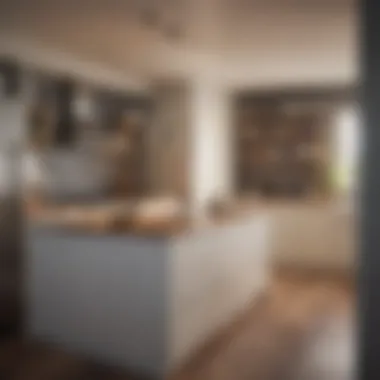
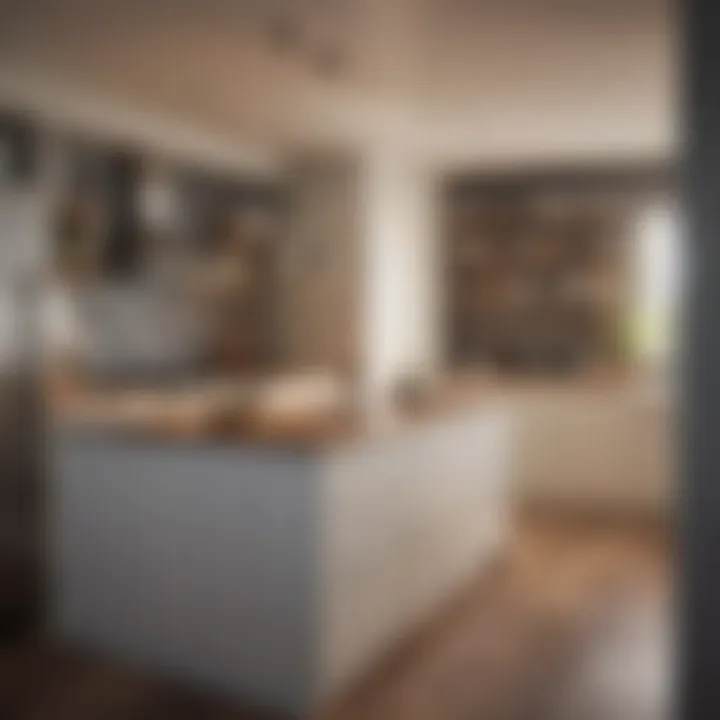
- Customization: Built-ins can be tailored to fit the specific dimensions of your kitchen, providing a more personalized solution.
- Integration: They can incorporate appliances, making them less obtrusive and better suited for a tight space.
- Aesthetic Appeal: They can provide a clean and unified look, which is beneficial in small areas where clutter can become overwhelming.
Benefits of built-in cabinetry:
- Maximizes vertical space, which is crucial in smaller kitchens.
- Allows for creative designs that can reflect your style.
- Increases property value due to the quality and thoughtfulness of the design.
Utilizing Vertical Space
Utilizing vertical space is essential in a 10x10 kitchen. Given that there is limited floor space, looking upwards can reveal new opportunities for storage. Wall-mounted shelves, cabinets that reach the ceiling, and hanging storage options like pot racks are practical solutions.
Strategies for effective vertical storage:
- Wall-Mounted Shelves: These can display items like spices or cookbooks, which not only saves space but also adds a decorative element.
- Tall Cabinets: Using cabinets that extend to the ceiling eliminates the awkward space above cabinets, which often becomes a dust collector.
- Hanging Racks: Install racks for pots and pans to keep them accessible while freeing cabinet space for other items.
Utilizing heights can transform the functionality of your kitchen, giving you more room for the essentials.
Multipurpose Furniture
Multipurpose furniture is another brilliant method to maximize storage in a small kitchen. Pieces that serve multiple functions can greatly reduce clutter and enhance the overall utility of the space. For instance, consider an island that provides both prep space and storage underneath, or a dining table with built-in drawers.
Popular options include:
- Storage Ottomans: These can double as seating and storage for kitchen linens or utensils.
- Foldable Tables: Great for saving space, they can be expanded when needed and tucked away otherwise.
- Convertible Islands: These can serve as a workspace, eating area, or additional storage as required.
"Incorporating multipurpose furniture can change the dynamics of how space is perceived and utilized in small kitchens."
Selecting Appliances for Limited Space
In a 10x10 kitchen, making choices about appliances is crucial. The right appliances can both enhance functionality and save valuable space. Every detail matters since smaller kitchens can quickly feel cramped if large or inappropriate items are selected. This section will explore various facets of selecting appliances specifically for limited spaces, providing guidance on compact options and addressing energy efficiency.
Compact Appliances Review
When considering appliances for a 10x10 kitchen, compact options are typically the best choice. These are designed to fit within smaller areas without sacrificing performance. One popular option is the Bosch 300 Series 24-Inch Dishwasher. While standard dishwashers often take up a lot of room, this model is designed to fit snugly in small kitchen spaces.
Moreover, Countertop Microwaves, like those made by Panasonic, can also save space. These microwaves can be placed on counters, freeing up space in kitchen cabinets. Look for models that offer advanced features in a compact design, such as sensor cooking.
Other appliances, such as Refrigerators, also have compact versions. For instance, Danby Designer 4.4 Cubic Feet Compact Refrigerator is an example that provides adequate space without overwhelming the room. For cooking, a Small Electric Cooktop can replace a full-sized stove, allowing you to cook efficiently while occupying minimal space.
In sum, selecting compact appliances has numerous benefits:
- Space Saving: Allows more room for movement and other necessary kitchen elements.
- Functionality: Enables efficient cooking and cleaning, even in small areas.
- Variety: Many brands now offer a range of compact models to suit various needs.
Energy Efficiency Considerations
Another essential factor when selecting appliances is energy efficiency. Choosing energy-efficient appliances not only reduces utility bills but also supports environmental sustainability. Look for appliances that have an Energy Star rating, which indicates that they meet certain energy efficiency guidelines.
The LG 3-Door French Door Refrigerator is an example of a high-efficiency model. It uses innovative technology to keep food fresh while consuming less energy than standard refrigerators. Similarly, Whirlpool’s Small Compact Washer is designed for efficiency in both size and energy usage.
Consider the following strategies to enhance energy efficiency in your 10x10 kitchen:
- Prioritize LED Lighting: It uses less energy than traditional lighting methods and has a longer lifespan.
- Use Smart Technology: Appliances with Wi-Fi connectivity allow you to monitor energy consumption.
- Choose Multi-Functional Appliances: Devices that combine cooking methods or functionalities reduce the need for multiple machines, saving energy overall.
Investing in energy-efficient appliances ultimately leads to long-term benefits. > "The upfront investment in energy-efficient models often pays off through lower energy bills and a reduced carbon footprint."
Color Schemes and Aesthetic Choices
Color schemes and aesthetic choices play a crucial role in small kitchen design, particularly for 10x10 spaces. These factors enhance not only the visual appeal but also the perceived space. When a room is painted in lighter colors, it often appears larger than it is. In contrast, darker hues can create a cozy atmosphere but may make the area feel smaller. Therefore, the selection of appropriate color palettes and finishes is significant in achieving the desired balance of aesthetics and functionality.
Choosing a Color Palette
Deciding on a color palette for your 10x10 kitchen requires careful consideration of personal taste and spatial dynamics. Lighter shades like whites, light grays, and pastels can open up the room. They reflect light and contribute to an airy feel. Additionally, accents in bolder colors can provide visual interest without overwhelming the small space. For example, incorporating navy blue or rich green as accent colors on one wall or through accessories can create a focal point while still maintaining an overall light ambiance.
Here are a few tips for selecting your color palette:
- Consider Coordination: Ensure colors coordinate with adjacent rooms. This allows for a seamless flow throughout your home.
- Use Neutrals: Neutrals can provide a calming backdrop and can be enhanced with colorful accessories.
- Test Samples: Always test color samples in different lighting conditions before committing. This allows you to see how the color affects the space at various times of the day.
Finishes That Enhance Space
Finishes contribute significantly to the overall aesthetic of your kitchen. They can elevate the design, making a small area feel more sophisticated. For instance, a high-gloss finish on cabinets reflects light, making the room feel more open and spacious. Contrarily, matte finishes can absorb light and might not be as effective in a compact setting.
Consider these finish options for your small kitchen:
- Glossy Cabinetry: This is a go-to choice for reflecting light and elevating modern designs.
- Textured Materials: Introducing textured materials, like a faux brick backsplash, can add depth without crowding the visual space.
- Quality Over Quantity: Choose fewer, high-quality materials. This approach reinforces the aesthetic without adding visual chaos.
"Using the right finishes and color combination can create an environment that's both inviting and functional, proving that even a small kitchen can have a big impact on design."
In summary, achieving a harmonious and appealing kitchen in a 10x10 space is highly contingent upon strategic color schemes and finishes. Paying attention to these detail can significantly enhance your kitchen's overall functionality and aesthetic charm.
Lighting Solutions for Small Kitchens
Lighting plays a crucial role in small kitchen design, particularly in spaces measuring 10x10 feet. Proper lighting not only enhances the ambiance but also contributes significantly to the functionality of the kitchen. Here, effective lighting can create the illusion of more space and improve visibility for cooking and food preparation. In smaller kitchen areas, layers of light allow for adaptability based on different tasks and moods, thereby maximizing usability without feeling cramped. Combining natural and artificial light is essential to achieve balance in aesthetics and practicality.
Layered Lighting Approaches
Layered lighting is an approach that involves the strategic use of different types of lighting to provide comprehensive illumination. In a small kitchen, this might include ambient, task, and accent lighting.
- Ambient lighting is the primary source of light that fills the entire kitchen. Ceiling fixtures or pendant lights can serve this purpose.
- Task lighting is directed at specific areas where practical work occurs. Under-cabinet lights are ideal for illuminating countertops, ensuring you can see clearly while chopping vegetables or reading recipes.
- Accent lighting adds depth and interest. By using decorative fixtures or LED strips within cabinetry, you can highlight architectural features or artwork, lending a personal touch to the space.
An effective layered lighting scheme doesn’t just benefit functionality; it also creates a warm and inviting atmosphere. A good plan will provide flexibility to suit various activities from cooking to entertaining.
Natural Light Optimization
Natural light is a valuable asset in any kitchen, especially small ones. It can brighten up the space and make it feel larger than its actual dimensions. Maximizing natural light involves thoughtful window placement and treatment. Here are some strategies:
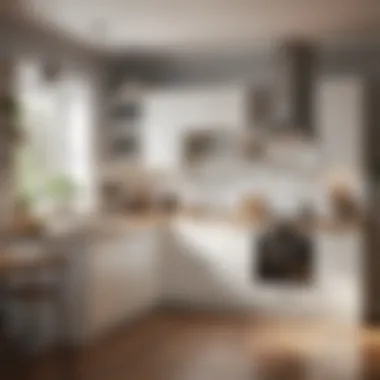

- Use sheer curtains or blinds to allow as much daylight in as possible while still providing some privacy.
- Position mirror elements strategically to reflect light, thereby amplifying its reach within the room. A well-placed mirror can serve both aesthetic and functional purposes, enhancing the perceived size of the space.
- Consider window placement during any remodel to capitalize on sunlight patterns throughout the day. A south-facing window will typically yield more natural light, while an east-facing window can provide beautiful morning light.
To summarize, blending both layered and natural lighting can result in a well-lit, functional, and appealing kitchen. Consideration of these elements will ensure a pleasant cooking environment while overcoming some of the challenges of small-space design.
"Introducing thoughtful lighting solutions in a small kitchen can significantly enhance both functionality and aesthetics, proving that every inch counts in these compact spaces."
Integrating these lighting solutions into a 10x10 kitchen design is key to realizing its full potential. Remember that a well-lit kitchen not only facilitates cooking but can also become a centerpiece of warmth and welcome in any home.
Functional Kitchen Workflows
In a small kitchen, such as a 10x10 foot space, optimizing workflows is crucial. Efficient workflows enhance the overall cooking experience. When designing a kitchen, one should consider how different areas interact with each other. Key elements include convenience, accessibility, and organization. When you create a system that allows for smoother transitions between tasks, you foster an environment that encourages creativity and productivity in the kitchen.
The concept of the kitchen triangle addresses the relationship between the stove, sink, and refrigerator. These areas comprise the core of kitchen activity. The distance between them affects efficiency. Therefore, ensuring that they are positioned within easy reach fosters a seamless workflow.
By establishing logical zones within the kitchen, you promote better organization and less clutter. The idea is simple: each zone should serve a specific function. This approach is beneficial, especially in a smaller space, as it maximizes the use of every square inch. Consider separating areas for cooking, cleaning, and food preparation, which enhances functionality and helps to eliminate chaos when preparing meals.
Factors to evaluate in functional kitchen workflows include:
- Ease of movement: Design pathways that allow for swift navigation between key areas.
- Accessibility of tools: Keep utensils and appliances close to where they are used most often.
- Work surface availability: Ensure ample counter space for meal prep without any hindrance.
"A well-designed kitchen flow leads to faster meal prep and a more enjoyable cooking experience, especially in compact spaces."
Efficient Kitchen Triangle Design
Efficient kitchen triangle design is a foundational principle for optimizing workflows in any kitchen. This method involves arranging the three primary work areas—the sink, stove, and refrigerator—into a triangular layout. In a 10x10 kitchen, where area is limited, applying this design becomes even more essential. Shortening the distance between these critical points reduces unnecessary steps throughout the cooking process.
An effective triangle should ideally have
- Spacing: Each side of the triangle should measure between 4 to 9 feet. This range ensures functionality while also providing adequate room for movement without cramping.
- Flow: Avoid unnecessary obstacles or interruptions between these areas. This results in a free-flowing design, facilitating multitasking when preparing meals.
- Safety: When deciding the layout, consider potential hazards. Ensure pathways are clear, mitigating risks associated with spills or hot surfaces.
Building these considerations into your kitchen layout can greatly enhance your cooking efficiency.
Zoning for Eating and Cooking Areas
Zoning refers to the division of a kitchen into different functional areas. In a small kitchen, establishing distinct zones for eating and cooking enhances usability. This practice is particularly relevant as it allows multiple people to work in the space without disrupting each other's activities.
Key elements of effective zoning include:
- Defining Areas: Clarify zones, like a cooking space for meal prep and a separate dining nook for eating. Use rugs or lighting to visually separate these areas.
- Flexible Furniture: Choose furniture that can serve dual purposes. For instance, a kitchen island can act as both preparation space and informal dining.
- Compact Seating: Consider bar stools or drop-leaf tables when selecting seating options. These choices can save space while providing a comfortable eating area.
This zoning strategy not only improves the overall kitchen functionality but also adds a sense of order to the cooking and dining experience. It allows for clear visibility of the tasks at hand while accommodating both solitary cooking sessions and social gatherings.
Flooring and Material Choices
Flooring and material choices play a crucial role in achieving both beauty and functionality in a 10x10 kitchen space. This section delves into why selecting the right flooring and materials is so essential. Firstly, in a small kitchen, the right flooring can make a space appear larger and more cohesive. A poorly chosen flooring type can create visual clutter, making it harder to maintain an inviting environment.
Additionally, materials impact durability, ease of maintenance, and comfort underfoot. Given the kitchen's various uses, the ideal flooring should be resistant to spills, stains, and wear from foot traffic. Thus, every choice is significant, influencing not just aesthetics but also practical daily use.
Choosing Durable Materials
When selecting durable materials for kitchen flooring, factors such as resistance to water and stains, longevity, and maintenance needs should be prioritized. Popular options include porcelain tiles, vinyl, and laminate, each having unique benefits.
Porcelain tiles are both water-resistant and durable. They can mimic the look of wood or stone, offering versatility in design without compromising on longevity. Vinyl flooring is another viable option, especially in a small kitchen. It is soft underfoot, easy to clean, and available in a range of styles. Furthermore, laminate flooring has improved in quality over the years, often presenting an attractive finish that can withstand heavy use.
Homeowners should also consider their lifestyle and potential wear and tear on the flooring when choosing materials. For example, if pets are in the home, options like vinyl or tiles might outperform others in terms of maintenance.
Visual Impact of Flooring
The visual impact of flooring cannot be overstated in a small kitchen. Color, texture, and pattern all contribute to the overall aesthetic and can create a crucial sense of space. Lighter colors tend to reflect more light, making the room feel larger and brighter. Conversely, dark flooring may make the kitchen appear smaller, but it can also create a cozy and intimate atmosphere.
Additionally, the texture of flooring contributes to the visual depth of the kitchen. Smooth surfaces reflect light, while textured surfaces can provide contrast and visual interest.
Choosing flooring patterns also impacts perceived space. A straight lay pattern can extend the visual lines of the room, making it seem larger, while a herringbone pattern can add elegance and sophistication without overwhelming the small area.
The right flooring can be a transformative element, enhancing both the attractiveness and functionality of a 10x10 kitchen.
Ultimately, homeowners should aim for a flooring choice that aligns with their style while ensuring functionality and ease of maintenance. By understanding the choices available and their implications, one can create a 10x10 kitchen that is not only beautiful but also a practical space suitable for daily life.
Incorporating Personal Style
Incorporating personal style into a small kitchen design is crucial for creating a space that is not only functional but also reflects individual preferences. A 10x10 kitchen can feel restrictive if not designed with care. Therefore, blending practical elements with personal touches can result in a cohesive and inviting environment. Personalized design choices can enhance the overall aesthetic and make the space a true extension of one's lifestyle.
Showcasing Personal Touches
Showcasing personal touches in a small kitchen can be achieved through various methods. Accessories, colors, and materials all play significant roles.
Some effective strategies include:
- Artwork: Hanging personal artwork or photographs can give the kitchen a unique flair. Selecting a few key pieces can showcase taste without overcrowding the space.
- Color Accents: Integrating favorite colors through accents such as dish towels, utensils, or small appliances can add character. For instance, a bright kettle or a patterned rug might enliven the area.
- Open Shelving: Displaying cherished dishware or collectibles on open shelves can provide personality and practical usage. This makes everyday items part of the decor rather than having them hidden away.
In essence, each item should serve a dual purpose, both functional and decorative, to make the most of the limited space.
Balancing Functionality with Aesthetics
To achieve a successful kitchen design, balancing functionality with aesthetics is essential. While style is important, the primary goal of a kitchen is to serve as an efficient workspace. Here are some key considerations:
- Multi-Functional Solutions: Use furniture or appliances that serve multiple purposes. For example, a kitchen island can provide extra countertop space and additional storage.
- Smart Storage Options: Well-designed cabinets that enhance aesthetics can help keep the kitchen organized. Choose styles that are visually appealing but also serve practical purposes, like pull-out shelves or lazy Susans.
- Durable Materials: Opt for materials that are both beautiful and easy to maintain. Choosing durable countertops like quartz can provide elegance without sacrificing functionality.
A cohesive design respects both style and usability, ensuring that the kitchen remains a pleasant area to work and gather. In this way, one can create an empowering space that reflects personal identity and lifestyle needs.
"A well-designed kitchen is an integral space that fosters connections and creativity, making personal style as essential as aesthetic appeal."
By carefully incorporating personal elements while ensuring that the kitchen remains practical, one can create an enjoyable and uniquely personal culinary environment.


Addressing Common Design Challenges
When designing a small kitchen, particularly in a 10x10 space, various challenges can surface. These design challenges can limit functionality and impede aesthetic appeal. Addressing these challenges effectively is essential for creating an efficient and attractive kitchen environment.
Understanding how to make the most out of the available space is crucial. Homeowners must consider elements such as ceiling height, natural light, and spatial illusions. These factors play a significant role in how the kitchen feels and functions. Overcoming design hurdles involves choosing the right materials, colors, and layouts. Solutions should center around enhancing both functionality and the user experience.
Dealing with Low Ceilings
Low ceilings can impact how spacious a kitchen feels. In a small kitchen, this can create a sense of confinement. However, there are several strategies to cope with lower ceilings. First, you might consider using light-colored paint or finishes. This can make the room feel less crowded and more open. Additionally, consider vertical storage options. High shelves or cabinets that stretch toward the ceiling help utilize every inch. It is also useful to select light fixtures that are flush with the ceiling to avoid a cramped appearance.
Creating Illusions of Space
Creating illusions of space is vital in a small kitchen. Clever use of design tricks can enhance the overall perception of size. Using mirrors is a popular strategy; they can reflect light and give depth. Furthermore, open shelving can create an airy feel. By limiting the number of cabinet doors and emphasizing vertical space, you promote a sense of continuity. Clear and transparent materials for cabinets also play a role; they make spaces look less cluttered.
Using the right colors and materials is key for creating an inviting atmosphere.
Optimizing natural light is another crucial element. Voile curtain or sheer blinds allow light to penetrate while maintaining privacy. Maximizing the sense of openness affects not just functionality but emotional comfort as well. Combining these solutions can help mitigate the common design challenges faced in small kitchen layouts.
Trends in Small Kitchen Design
The trend of designing small kitchens has evolved considerably in recent years. With urban living at its peak, many homeowners find themselves in need of effective ways to make the most out of limited spaces. Small kitchens do not mean compromising style or function; instead, they offer a unique opportunity for innovation and creativity. This section examines recent trends that are reshaping small kitchen spaces, particularly for the 10x10 dimensions. Understanding these trends helps create functional layouts that enhance everyday living.
Sustainable Solutions
Sustainability has become central in modern design philosophies. Homeowners now favor materials and practices that minimize their environmental footprint. In small kitchens, this trend manifests through:
- Eco-Friendly Materials: Using bamboo, recycled glass, or reclaimed wood can make a significant difference. These materials not only reduce waste but also bring unique textures and colors to the kitchen.
- Energy-Efficient Appliances: Investing in appliances that meet energy standards can contribute to lower energy bills. Look for labels such as ENERGY STAR that indicate efficiency without sacrificing performance.
- Water Conservation Fixtures: Install low-flow faucets and energy-efficient dishwashers to save water. This feature becomes essential in a small kitchen where every drop counts.
Integrating such solutions not only elevates the kitchen's functionality but also aligns with a growing commitment to environmental responsibility. Sustainable solutions enhance the appeal and value of the space.
Minimalist Approaches
Minimalism remains a significant influence on small kitchen design. The philosophy centers around simplicity, focusing on essential elements while eliminating the clutter. This approach has various advantages:
- Maximized Space: By keeping only necessary items, the kitchen feels more open. Each piece should serve a purpose, reducing visual noise.
- Functional Design Features: Minimalist kitchens often include smart storage solutions like under-counter cabinets or pull-out shelves. These elements help optimize limited space and ensure everything is within easy reach.
- Neutral Color Palettes: Soft and neutral colors can create an illusion of a bigger space. Light shades reflect more light, making the kitchen feel airy and spacious, even in constrained environments.
"Incorporating minimalism does not mean sacrificing style. It means choosing quality over quantity, resulting in a harmonious and functional space."
By embracing minimalism, homeowners can create elegant kitchens that are both practical and visually appealing. Ultimately, these trends highlight that small kitchens can be transformed into efficient, stylish areas of the home.
Inspiration from Real-Life Examples
Inspiration plays a pivotal role in the design process, especially when it comes to small kitchen layouts. The 10x10 kitchen space, while compact, presents unique opportunities for creativity and functionality. By studying real-life examples, homeowners and designers can uncover strategies that optimize space, enhance practicality, and elevate aesthetics. This section delves into notable case studies and vital lessons learned from successful designs.
Case Studies of 10x10 Kitchens
When examining case studies of various 10x10 kitchens, one finds diverse approaches to maximizing limited space. For instance, a transitional style kitchen in Cleveland effectively utilizes open shelving to create an airy feel. The lack of upper cabinets opens up the visual space, making the kitchen seem larger. Clever lighting techniques amplify this effect, integrating under-cabinet lights that enhance the workspace while adding warmth to the design.
Another example can be found in a minimalist kitchen design in Seattle. Here, the use of a large island serves as a multi-functional component. Not only does it provide cooking space, but it also accommodates seating and storage. Integrating elements like pull-out drawers can streamline the workflow and maintain an uncluttered look in this tight area.
Lessons from Successful Designs
From these noteworthy cases, several lessons emerge that can guide anyone designing a small kitchen space.
- Prioritize Functionality: Each element should serve a purpose. Whether it’s consolidated storage or adaptable surfaces, every choice must enhance the kitchen’s efficiency.
- Embrace Verticality: Utilizing vertical space for storage can free up counter space and declutter the kitchen layout. High cabinets or tall shelves can be great for items not frequently used.
- Consistent Color Schemes: Maintaining a cohesive color palette helps to create a sense of harmony. Light colors, particularly whites or soft pastels, can make the space appear larger.
- Smart Appliance Selection: Choose smaller or integrated appliances that do not overwhelm the space. Brands like Bosch and Whirlpool offer compact options that fit seamlessly within cabinetry.
"The best small kitchen designs blend creativity with practicality, ensuring that every inch counts while reflecting the homeowner's unique style."
Exploring these inspirations allows for a deeper understanding of how to tailor a 10x10 kitchen design to meet individual needs while staying stylish. Designers and homeowners alike can take cues from these successful implementations to craft their ideal space.
Resources for Small Kitchen Solutions
Designing a small kitchen can be a daunting task. Resources for Small Kitchen Solutions play a crucial role in achieving a functional and aesthetically pleasing environment. These resources encompass a variety of tools, software, inspiration sources, and practical guides. By utilizing these resources, homeowners and design enthusiasts can navigate the challenges that come with small spaces. The correct utilization of design resources not only saves time but also helps in making informed decisions that greatly enhance the final outcome.
Utilizing various tools can provide clear visualizations of how a 10x10 kitchen might look. Similarly, understanding where to find inspiration can spark creativity and offer new ideas for personal touches. The importance of these resources cannot be overstated, as they can lead to innovative designs that cater specifically to the limitations and opportunities of small kitchens.
Design Software and Tools
With the rise of technology, design software has become an invaluable asset. Programs like SketchUp or AutoCAD allow users to create detailed kitchen layouts. Users can easily manipulate dimensions, adjust layouts, and visualize different configurations. This flexibility is key when designing for a space that is just 10x10 feet.
- 3D visualization: Software can provide three-dimensional representations of kitchen designs. This assists homeowners in seeing their ideas in a tangible way.
- Powerful editing tools: Users can experiment with various elements such as cabinets, countertops, and appliances. Making adjustments to colors and materials become easy and straightforward.
- Cost estimation: Some software offers features that allow users to estimate costs based on selected materials and designs. This can be essential in working within a budget.
Where to Find Inspiration
Finding the right inspiration can significantly influence the design process. Here are several sources for discovering new ideas for a small kitchen:
- Design magazines: Publications that focus on interior design often showcase small kitchen designs. They provide real images and ideas that can be implemented.
- Social media platforms: Websites like Instagram and Pinterest are treasure troves for modern design. Hashtags such as #SmallKitchen or #KitchenInspo can yield countless ideas.
- Home improvement websites: Websites like Houzz or Better Homes & Gardens offer extensive galleries. These sites often have user reviews and suggestions that can be very helpful.
Final Thoughts on Small Kitchen Design
In this article, we explored numerous facets of designing a small kitchen, specifically tailored for 10x10 foot spaces. The significance of thoughtful design in compact layouts cannot be overstated. Small kitchens present unique challenges, yet they also provide an opportunity for creative solutions that enhance both functionality and aesthetic appeal. Understanding how to navigate these challenges can lead to a space that is not only efficient but also inviting.
Summing Up Key Takeaways
To recap, there are several important points to remember when designing a small kitchen:
- Space Planning: Maximizing every square inch requires careful consideration of layout and flow. Each area must be functional without feeling cramped.
- Storage Solutions: Utilizing vertical space, built-ins, and multipurpose furniture creates ample storage while maintaining openness.
- Appliance Selection: Compact appliances can provide essential functions without overwhelming a small kitchen.
- Color and Lighting: A light color palette and varied lighting options can make a small space feel larger and more welcoming.
- Personal Touches: Integrating personal style factors into the design makes any kitchen feel like home.
These elements all contribute to a small kitchen that does not sacrifice style for function.
Encouragement for Creative Solutions
While challenges exist in designing a kitchen of limited size, embracing creativity can yield exceptional results. Think outside traditional boundaries. Consider:
- Customized Design: Working with professionals to create a tailored layout that showcases personal needs and preferences.
- Innovative Materials: Exploring unconventional materials that might provide both durability and visual appeal.
- Sustainable Choices: Implementing eco-friendly solutions not only benefits the environment but can also contribute to unique design elements.
Every homeowner has the potential to make their 10x10 kitchen an organized, beautiful space. By introducing fresh ideas, investing time, and committing to a design vision, one can transform challenges into assets.
In summary, a small kitchen can become a functional work of art that expresses individuality, enhances productivity, and improves day-to-day living.
Design is an ongoing process. Encourage experimentation and adaptability as tastes evolve and needs change. You have the power to create a small kitchen that reflects your style while being practical and efficient.



